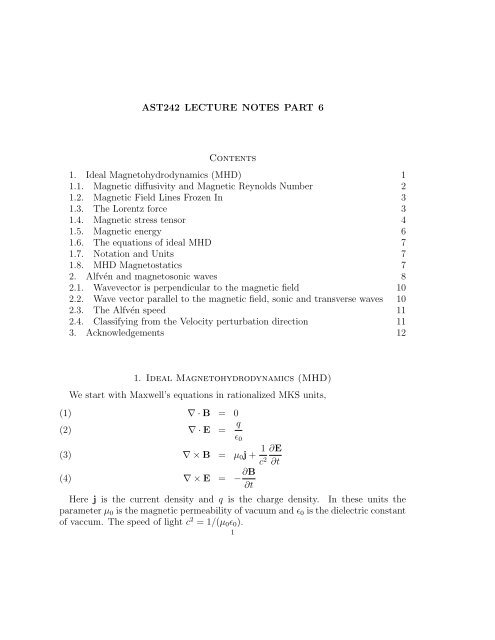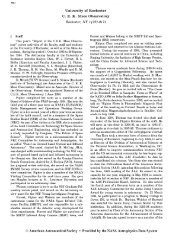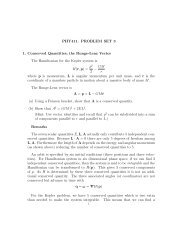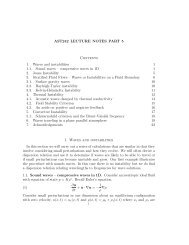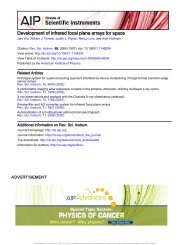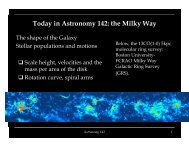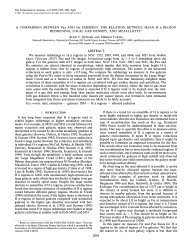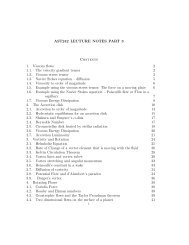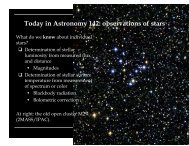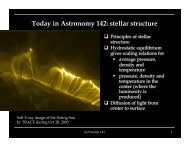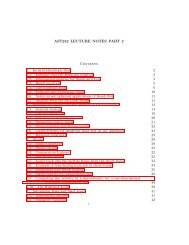AST242 LECTURE NOTES PART 6 Contents 1. Ideal - Astro Pas ...
AST242 LECTURE NOTES PART 6 Contents 1. Ideal - Astro Pas ...
AST242 LECTURE NOTES PART 6 Contents 1. Ideal - Astro Pas ...
You also want an ePaper? Increase the reach of your titles
YUMPU automatically turns print PDFs into web optimized ePapers that Google loves.
<strong>AST242</strong> <strong>LECTURE</strong> <strong>NOTES</strong> <strong>PART</strong> 6<strong>Contents</strong><strong>1.</strong> <strong>Ideal</strong> Magnetohydrodynamics (MHD) 1<strong>1.</strong><strong>1.</strong> Magnetic diffusivity and Magnetic Reynolds Number 2<strong>1.</strong>2. Magnetic Field Lines Frozen In 3<strong>1.</strong>3. The Lorentz force 3<strong>1.</strong>4. Magnetic stress tensor 4<strong>1.</strong>5. Magnetic energy 6<strong>1.</strong>6. The equations of ideal MHD 7<strong>1.</strong>7. Notation and Units 7<strong>1.</strong>8. MHD Magnetostatics 72. Alfvén and magnetosonic waves 82.<strong>1.</strong> Wavevector is perpendicular to the magnetic field 102.2. Wave vector parallel to the magnetic field, sonic and transverse waves 102.3. The Alfvén speed 112.4. Classifying from the Velocity perturbation direction 113. Acknowledgements 12(1)(2)(3)(4)<strong>1.</strong> <strong>Ideal</strong> Magnetohydrodynamics (MHD)We start with Maxwell’s equations in rationalized MKS units,∇ · B = 0∇ · E = q ɛ 0∇ × B = µ 0 j + 1 ∂Ec 2 ∂t∇ × E = − ∂B∂tHere j is the current density and q is the charge density. In these units theparameter µ 0 is the magnetic permeability of vacuum and ɛ 0 is the dielectric constantof vaccum. The speed of light c 2 = 1/(µ 0 ɛ 0 ).1
2 <strong>AST242</strong> <strong>LECTURE</strong> <strong>NOTES</strong> <strong>PART</strong> 6Ohm’s law(5) j = σ(E + u × B)where σ is the electric conductivity. This follows as material moving with velocity uis subject to a total electric field E + u × B.For ideal MHD we are going to take the non-relativistic limit and that of highconductivity. For the non-relativistic limit we ignore the term 1 ∂Ein the third ofc 2 ∂tMaxwell’s equations above. Thus we approximate(6) ∇ × B = µ 0 j = µ 0 σ(E + u × B)where I have used Ohm’s law for j. Taking the curl of the equation(7) ∇ × (∇ × B) = µ 0 σ(∇ × E + ∇ × (u × B))The vector identity(8) ∇ × (∇ × B) = −∇ 2 B − ∇(∇ · B) = −∇ 2 Bsince ∇ · B = 0. Using the vector identity and the last of Maxwell’s equations,equation (7) becomes((9) −∇ 2 B = µ 0 σ − ∂B)∂t + ∇ × (u × B)We rewrite this(10)∂B∂t= ∇ × (u × B) +1σµ 0∇ 2 B<strong>1.</strong><strong>1.</strong> Magnetic diffusivity and Magnetic Reynolds Number. If the fluid is notmoving, u = 0, then the above equation looks like∂B(11)∂t = 1 ∇ 2 Bσµ 0which is a diffusion equation and we can define the diffusion coefficient(12) η ≡ 1σµ 0This coefficient, η, is called the magnetic diffusivity. The magnetic field diffusesor leaks through the material. For laboratory conductors the decay timescale foroppositely directed fields to decay is fairly short. However in astrophysical plasmasthe decay timescale can be long.We can define what is called a magnetic Reynolds number, R M , using our diffusioncoefficient, the magnetic diffusivity,(13) R M ≡ LV η
4 <strong>AST242</strong> <strong>LECTURE</strong> <strong>NOTES</strong> <strong>PART</strong> 6We now consider the momentum equations for each component of the fluid takinginto account the Lorentz force(23) F = e(E + u × B)(24)( )∂um + n + ++ (u · ∇)u +∂t( )∂um − n − −+ (u · ∇)u −∂t= e + n + (E + u + × B) − f + ∇p= e − n − (E + u − × B) − f − ∇pIf we add the pressure terms we will get the total pressure force on the fluid element.We sum the previous two equations to find[ ]∂u(25) ρ∂t + (u · ∇)u = qE + j × B − ∇pLet’s reconsider equation (6) (Maxwell’s equation but neglecting the relativisticterm)(26) µ 0 j = ∇ × BUsing this equation the Lorentz force becomes(27) qE + 1 µ 0(∇ × B) × BThe term proportional to E we assume is negligible because we do not expect chargeseparation. With this in mind our equation for momentum conservation (Euler’sequation) becomes[ ]∂u(28) ρ∂t + (u · ∇)u = 1 (∇ × B) × B − ∇pµ 0The right hand side shows that our fluid element has an additional force on it dueto the magnetic field.<strong>1.</strong>4. Magnetic stress tensor. It may be useful later on to write our equation forconservation of momentum in conservation law form. For our Lorentz force density(29) f = µ −10 (∇ × B) × BSince the force is a cross product with B the force is always perpendicular to thefield lines.
(30)<strong>AST242</strong> <strong>LECTURE</strong> <strong>NOTES</strong> <strong>PART</strong> 6 5We use summation notation to find a different form for the force density,so that(31) f = µ −10f i = ɛ ijk ɛ jlm B m,l B k= ɛ jki ɛ jlm B m,l B k= (δ kl δ im − δ km δ il )B m,l B k= B i,k B k − B k,i B k[(B · ∇)B − ∇( )] B2With this force Euler’s equation becomes[ ] [( )]∂uB(32) ρ∂t + (u · ∇)u = µ −120 (B · ∇)B − ∇ − ∇p2The B · ∇)B term is referred to as the force due to magnetic tension. The termproportional to ∇B 2 is described as a force due to magnetic pressure.We can also describe f in terms of a divergence(33) f = ∇ · m with f i = ∂m ij∂x jwhere m is a magnetic stress tensor and(34) m = µ −10or with indexes(35) m ij = µ −102(B ⊗ B − 1 2 B2 g)(B i B j − 1 2 B2 δ ij)Here g is the coordinate tensor we used previous for the part of the stress tensordependent on pressure. Note that the second term is diagonal. ( In our equation forBconservation of momentum this term would become −∇22µ 0). Its sign is the sameas the pressure term. This means it acts just like a pressure. The magnetic pressure(36) P mag = B22µ 0in rationalized MKS units with B in Tesla. In cgs(37) P mag = B28πwith B in units of Gauss. The other term in our force density, µ −10 (∇ · B)B, isdescribed as a magnetic tension along the field lines. It arises from a term in the
6 <strong>AST242</strong> <strong>LECTURE</strong> <strong>NOTES</strong> <strong>PART</strong> 6magnetic stress tensor that looks similar to the ram pressure term we saw in thestress tensor for our equation for conservation of momentum. In conservation lawform we can write our conservation of momentum as(38)∂(ρu)∂t+ ∇ · (π − m) = −ρ∇Φwhere π = pg + ρu ⊗ u and the magnetic stress tensor m is given by equation (34).Figure <strong>1.</strong> The force due to magnetic pressure is shown on the left.The curvature force due to magnetic tension is shown on the right.Both are perpendicular to the field lines. This figure is taken from KipThorne’s notes.<strong>1.</strong>5. Magnetic energy. The magnetic energy density is(39)B 22µ 0and is then included as an additional term in our total energy per unit volume E.The total energy flux picks up an an additional term the Poynting flux, µ −10 E × B,which we can neglect in the MHD approximation because we neglect the electric field.Just as viscosity increases entropy through viscous dissipation, electrical conductivityand associated magnetic dissipation will give an entropy increase through Ohmicdissipation. Our equation for conservation of energy[ ( ) ] [ ( )∂ u2ρ∂t 2 + e + Φ + B2u2+ ∇ · ρu2µ 0 2 + h + Φ + E × B ](40)= 0µ 0where I have neglected ˙Φ, viscous dissipation, self-gravity, heating and cooling andthermal electric conduction.
<strong>AST242</strong> <strong>LECTURE</strong> <strong>NOTES</strong> <strong>PART</strong> 6 7<strong>1.</strong>6. The equations of ideal MHD. We have assumed sub-relativistic flow, andhigh conductivity. In this limit we find that the magnetic field is frozen into thefluid. We also assume no charge separation. Let us summarize the equations neededto describe the system.Conservation of mass∂ρ(41)∂t + ∇ · (ρu) = 0Conservation of momentum(42) ρ( ∂u∂t + (u · ∇)u )= 1 µ 0(∇ × B) × B − ∇p − ρ∇Φwhere I have added a gravitational term.And because we now have an additional vector field we need to evolve it as well.We have the induction equation∂B(43)= ∇ × (u × B)∂tThese three equations (along with an equation of state, and an equation for conservationof energy and ∇ · B = 0) represent the ideal MHD approximation.<strong>1.</strong>7. Notation and Units. The electric field has dropped out of all the equations.The magnetic field appears in the induction equation and in the Lorentz force. Theinduction equation contains B on both sides of the equation so it doesn’t matterwhat units are used for B. For the Lorentz force the magnetic field enters in asB 2 /µ 0 , in rationalized MKS units so the magnetic field is in Tesla. We could replaceB 2 /µ 0 with B 2 /(4π) and work in cgs with magnetic field in units of Gauss.<strong>1.</strong>8. MHD Magnetostatics. We look at our evolution equations setting all timederivatives to zero and setting the velocity to zero. We find only one interestingequation which is a hydrostatic equilibrium equation1(44)(∇ × B) × B = ∇p + ρ∇Φµ 0This equation is used to look at the structures of coronal loops, sunspots and themagnetic field above the magnetic plane.Let us reformulate the magnetostatic equation above in terms of a vector potential,A(45) B = ∇ × AThis automatically satisfies ∇ · B = 0.(46) ∇ × B = ∇ × (∇ × A) = ∇(∇ · A) − ∇ 2 A
8 <strong>AST242</strong> <strong>LECTURE</strong> <strong>NOTES</strong> <strong>PART</strong> 6Now consider the Lorenz force(47) f = µ −10 (∇ × B) × B = µ −10[∇(∇ · A) − ∇ 2 A ] × (∇ × A)In two dimensions this is much simpler. Assume for example that B lies in the y, zplane. Then we may choose A to have a single component in the x direction thatonly depends on y, z. In this case the above is particularly simple since ∇ · A = 0(48) f = −µ −10 (∇ 2 A)∇AWhy did I do this exactly? I thought it would be more interesting than it was.Lots more can be done here! For example we can look at how magnetic pressurecan give buoyancy. There is a nice section on in Pringle and King on magneticinstability in a static atmosphere. Clarke and Carswell discuss magnetic stabilizationof the Rayleigh-Taylor instability.2. Alfvén and magnetosonic wavesAlfvén waves are hydromagnetic waves in an incompressible fluid. Here we followthe derivation by Jackson, and don’t assume incompressibility just yet. If thegas is not necessarily assumed to be incompressible then we would call the wavesmagnetosonic waves.We start with our equations of ideal MHD:( )∂u(49)ρ∂t + (u · ∇)u = 1 (∇ × B) × B − ∇pµ 0∂B(50)= ∇ × (u × B)∂t∂ρ(51)= −∇ · (ρu)∂twhere the first equation is for momentum, the second is the induction equation andthe last equation the continuity equation. We assume unperturbed flow with B 0independent of position and u 0 = 0.We linearize the three equations only taking first order terms(52)∂ρ 1∂t= −ρ 0 (∇ · u 1 )∂u 1(53)ρ 0 = −c 2∂ts∇ρ 1 − µ −10 B 0 × (∇ × b 1 )∂b 1(54)= ∇ × (u 1 × B 0 )∂twhere c s is the acoustic sound speed.
<strong>AST242</strong> <strong>LECTURE</strong> <strong>NOTES</strong> <strong>PART</strong> 6 9We take the time derivative of the second equation∂ 2(55) u 1= − c2 s∇ ∂ρ 1∂t 2 ρ 0 ∂t − B 0× (∇ × ∂b 1µ 0 ρ 0 ∂t )= c 2 s∇(∇ · u 1 ) − B 0(56)× (∇ × ∇ × (u 1 × B 0 ))µ 0 ρ 0where we have inserted expressions from the linearized equation of continuity andinduction equation.We define a velocity vector(57) v A = B 0√µ0 ρ 0and insert it into the previous equation∂u 1(58)∂t = 2 c2 s∇(∇ · u 1 ) − v A × (∇ × ∇ × (u 1 × v A ))Henceforth we will refer to the length of this velocity vector, |v A |, as the Alfvenspeed.This looks pretty nasty but it is essentially a wave equation for u 1 . The velocityperturbation can be related to the magnetic field perturbation, b 1 , using the inductionequation. Note that the leftmost term on the right hand side is zero if the fluidis incompressible.We assume a perturbation in the following form(59)We derive the following relationu = u 1 e i(k·x−ωt)(60) −ω 2 u 1 = −c 2 s(k · u 1 )k + v A × (k × k × (u 1 × v A ))We can use the following vector identity(61) A × (B × C) = B(A · C) − C(A · B)so that(62) k × (u 1 × v A ) = u 1 (k · v A ) − v A (k · u 1 )Equation (60) becomes(63)−ω 2 u 1 + c 2 s(k · u 1 )k = v A × [k × (u 1 (k · v A ) − v A (k · u 1 ))]We use the vector identity again(64)= v A × (k × u 1 ) (k · v A ) + v A × (v A × k)(k · u 1 )−ω 2 u 1 + c 2 s(k · u 1 )k = [k(v A · u 1 ) − u 1 (v A · k)] (k · v A )+ [ v A (v A · k) − kv 2 A](k · u1 )
10 <strong>AST242</strong> <strong>LECTURE</strong> <strong>NOTES</strong> <strong>PART</strong> 6or(65)−ω 2 u 1 + (c 2 s + v 2 A)(k · u 1 )k =(k · v A ) [k(v A · u 1 ) − u 1 (v A · k) + v A (k · u 1 )]This equation should let us discuss all magnetosonic waves. Taking the limit ofc s = 0 is equivalent to assuming that the magnetic pressure is much larger than thegas pressure. In this case all waves propagate at the Alfven velocity.2.<strong>1.</strong> Wavevector is perpendicular to the magnetic field. If k is perpendicularto B 0 (and so v A ) then the right hand side of Equation (65) is zero. In this case theabove equation becomes(66) −ω 2 u 1 + (c 2 s + v 2 A)(k · u 1 )k = 0and u 1 must be parallel to k. This means the waves are longitudinal. The dispersionrelation(67) ω 2 = (c 2 s + v 2 A)k 2so the wave speed is(68) s =√c 2 s + v 2 AIt’s a fast wave with velocity larger than both sound and Alfven velocities. Bothmagnetic and gas pressure resist the compression and so contribute to the restoringforce.2.2. Wave vector parallel to the magnetic field, sonic and transverse waves.If k is parallel to B 0 then k(v A · u 1 ) = v A (k · u 1 ). Equation (65) becomes(69) (v 2 Ak 2 − ω 2 )u 1 = −(c 2 s + v 2 A)(k · u 1 )k + 2k(v A · u 1 )(k · v A )This can be simplified by assuming k = av A (with a 2 = k 2 /vA 2 ) to manipulate theequation( )(70) (vAk 2 2 − ω 2 )u 1 = 1 − c2 sk 2 (vvA2 A · u 1 )v AWe consider two cases:a) u 1 is parallel to k and v A . The waves are longitudinal. The dispersion relation is( )(71) (vAk 2 2 − ω 2 ) = 1 − c2 sk 2 v 2vA2 Awhich simplifies to(72) ω 2 = c 2 sk 2These are ordinary acoustic waves.
12 <strong>AST242</strong> <strong>LECTURE</strong> <strong>NOTES</strong> <strong>PART</strong> 6We find ω 2 = v 2 A k2 and have Alfven waves. Because u 1 is perpendicular to k thewaves are transverse only.We now consider the case where u 1 lies in the plane containing B and k. Let k bein the positive x direction. Furthermore let ψ be the angle between the two vectorsv A and k so that v A = v A (cos ψ, sin ψ, 0) and k · v A = kv A cos ψ. The dispersionrelation (equation 65) becomes(−ω 2 + (c 2 s + v 2 A)k 2 )u 1,x = k 2 v 2 A cos ψ [(cos ψu 1,x + sin ψu 1,y ) − cos ψu 1,x + cos ψu 1,x ]−ω 2 u 1,y = k 2 v 2 A cos ψ [−u 1,y cos ψ + sin ψu 1,x ]Simplify the first equation and use the second to solve for u 1,y(−ω 2 + (c 2 s + v 2 A)k 2) u 1,x = k 2 v 2 A cos ψ(sin ψu 1,y + cos ψu 1,x )(77)(78)u 1,y = (k 2 v 2 A cos 2 ψ − ω 2 ) −1 k 2 v 2 A sin ψ cos ψu 1,xInserting the expression for u 1,y into the previous equation[−ω 2 + c 2 sk 2 + (1 − cos 2 ψ)v 2 Ak 2] (k 2 v 2 A cos 2 ψ − ω 2 ) = k 4 v 4 A cos 2 ψ sin 2 ψ(79)ω 4 − ω 2 k 2 (c 2 s + v 2 A) + k 4 v 2 A cos 2 ψ = 0which is a quartic equation for ω but only involving ω 4 and ω 2 and constant terms.The solution isω 2= 1 [ √](80)(v 2k 2 a + c 22s) ± (vA 2 + c2 s) 2 − 4vA 2 c2 s cos 2 ψThe positive roots are called “fast” waves and the negative ones are “slow” waves.The previous two cases are independent. It would be nice to show this here.Notes: For high enough frequencies the frequency can be comparable to the oscillationfrequency of individual particles in the plasma. In this case the single fluidmodel breaks down.3. AcknowledgementsDrawing heavily on Pringle and King, Clarke and Carswell and and old favoriteof mine called Magnetohydrodynamics by T. G. Cowling, 1976. The figure is thesame as Figure 18.3 from Kip Thorne’s notes. Following Jackson’s Classical Electrodynamicsfor Alfvén waves.


